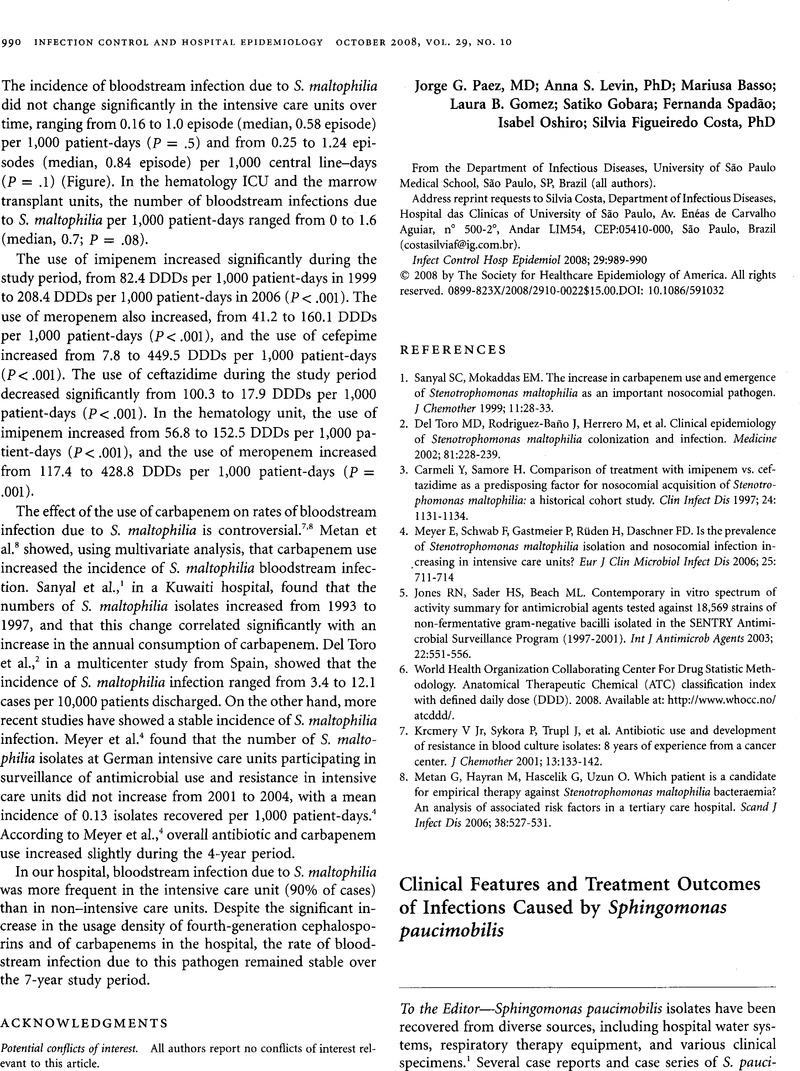Crossref Citations
This article has been cited by the following publications. This list is generated based on data provided by Crossref.
Mancini, M.
Panasiti, V.
Devirgiliis, V.
Pietropaolo, V.
Fioriti, D
Nicosia, R.
Curzio, M.
Roberti, V.
Gobbi, S.
Bottoni, U.
Chiarini, F.
and
Calvieri, S.
2009.
Bromhidrosis Induced by Sphingomonas Paucimobilis: A Case Report.
International Journal of Immunopathology and Pharmacology,
Vol. 22,
Issue. 3,
p.
845.
STEINBERG, JAMES P.
and
BURD, EILEEN M.
2010.
Mandell, Douglas, and Bennett's Principles and Practice of Infectious Diseases.
p.
3015.
Ryan, M.P.
and
Adley, C.C.
2010.
Sphingomonas paucimobilis: a persistent Gram-negative nosocomial infectious organism.
Journal of Hospital Infection,
Vol. 75,
Issue. 3,
p.
153.
Toh, Han-Siong
Tay, Hung-Tze
Kuar, Wei-Khie
Weng, Tzu-Chieh
Tang, Hung-Jen
and
Tan, Che-Kim
2011.
Risk factors associated with Sphingomonas paucimobilis infection.
Journal of Microbiology, Immunology and Infection,
Vol. 44,
Issue. 4,
p.
289.
Mutlu, Mehmet
Bayramoglu, Gülçin
Yilmaz, Gürdal
Saygin, Berna
and
Aslan, Yakup
2011.
Outbreak of Sphingomonas paucimobilis septicemia in a neonatal intensive care unit.
Indian Pediatrics,
Vol. 48,
Issue. 9,
Brady, Michael T.
and
Marcon, Mario J.
2012.
Principles and Practice of Pediatric Infectious Diseases.
p.
832.
Lanoix, J.-P.
Hamdad, F.
Borel, A.
Thomas, D.
Salle, V.
Smail, A.
El Samad, Y.
and
Schmit, J.-L.
2012.
Sphingomonas paucimobilis bacteremia related to intravenous human immunoglobulin injections.
Médecine et Maladies Infectieuses,
Vol. 42,
Issue. 1,
p.
37.
Burns, Jane L.
2012.
Principles and Practice of Pediatric Infectious Diseases.
p.
841.
Kuehn, Joanna S.
Gorden, Patrick J.
Munro, Daniel
Rong, Ruichen
Dong, Qunfeng
Plummer, Paul J.
Wang, Chong
Phillips, Gregory J.
and
van Schaik, Willem
2013.
Bacterial Community Profiling of Milk Samples as a Means to Understand Culture-Negative Bovine Clinical Mastitis.
PLoS ONE,
Vol. 8,
Issue. 4,
p.
e61959.
Gil-Diaz, A.
Estevez-Dominguez, R.
Daryanani-Daryanani, R.
Gil-Reyes, J.
and
Monzon-Moreno, C.
2014.
Fever of unknown origin in a young man.
Irish Journal of Medical Science (1971 -),
Vol. 183,
Issue. 3,
p.
461.
García-Lozano, Tomás
García-García, Ana M.
Iranzo-Tatay, Agustín
and
Aznar-Oroval, Eduardo
2015.
First case of bacteremia by Sphingomonas anadarae in a patient with cancer.
Medicina Clínica (English Edition),
Vol. 145,
Issue. 10,
p.
459.
Romano-Bertrand, Sara
Frapier, Jean-Marc
Calvet, Brigitte
Colson, Pascal
Albat, Bernard
Parer, Sylvie
and
Jumas-Bilak, Estelle
2015.
Dynamics of the surgical microbiota along the cardiothoracic surgery pathway.
Frontiers in Microbiology,
Vol. 5,
Issue. ,
García-Lozano, Tomás
García-García, Ana M.
Iranzo-Tatay, Agustín
and
Aznar-Oroval, Eduardo
2015.
Primer caso de bacteriemia por Sphingomonas anadarae en un paciente con cáncer.
Medicina Clínica,
Vol. 145,
Issue. 10,
p.
459.
Demiray, Tayfur
Koroglu, Mehmet
Ozbek, Ahmet
and
Altindis, Mustafa
2016.
Detection and Clinical Implications of Biofilm Formation Among Clinical Isolates of Sphingomonas paucimobilis in Turkey.
Jundishapur Journal of Microbiology,
Vol. 10,
Issue. 1,
Hardjo Lugito, Nata Pratama
Cucunawangsih
and
Kurniawan, Andree
2016.
A Lethal Case ofSphingomonas paucimobilisBacteremia in an Immunocompromised Patient.
Case Reports in Infectious Diseases,
Vol. 2016,
Issue. ,
p.
1.
Santarelli, A.
Mascitti, M.
Galeazzi, R.
Marziali, A.
Busco, F.
and
Procaccini, M.
2016.
Oral ulcer by Sphingomonas paucimobilis: first report.
International Journal of Oral and Maxillofacial Surgery,
Vol. 45,
Issue. 10,
p.
1280.
Campos-Franco, Joaquín
Barbeito-Castiñeiras, Gema
Sánchez-Leira, Joaquín
and
Pardo-Sánchez, Fernanda
2016.
Peritonitis bacteriana espontánea por Sphingomonas paucimobilis en un paciente cirrótico.
Enfermedades Infecciosas y Microbiología Clínica,
Vol. 34,
Issue. 7,
p.
462.
Bermudez-Brito, Miriam
Faas, Marijke M
and
de Vos, Paul
2016.
Modulation of Dendritic-Epithelial Cell Responses against Sphingomonas Paucimobilis by Dietary Fibers.
Scientific Reports,
Vol. 6,
Issue. 1,
Gulati, Parul
and
Ghosh, Moushumi
2017.
Biofilm forming ability of Sphingomonas paucimobilis isolated from community drinking water systems on plumbing materials used in water distribution.
Journal of Water and Health,
Vol. 15,
Issue. 6,
p.
942.
Jin, Ding Xing
Zou, Hua Wei
Liu, Si Qiang
Wang, Li Zhi
Xue, Bai
Wu, De
Tian, Gang
Cai, Jingyi
Yan, Tian Hai
Wang, Zhi Sheng
and
Peng, Quan Hui
2018.
The underlying microbial mechanism of epizootic rabbit enteropathy triggered by a low fiber diet.
Scientific Reports,
Vol. 8,
Issue. 1,



